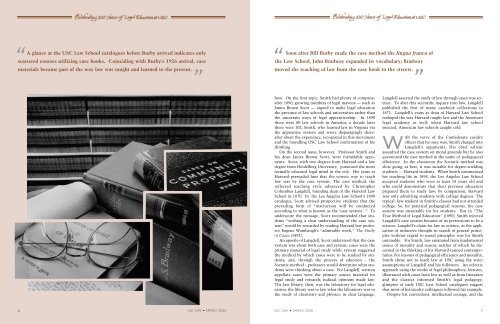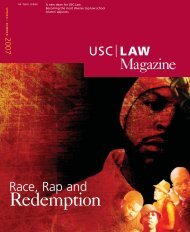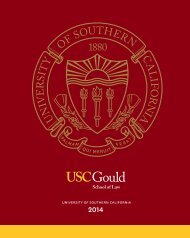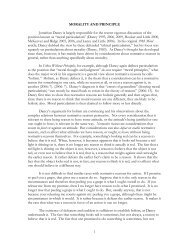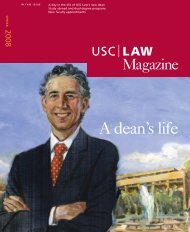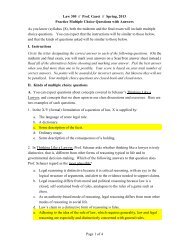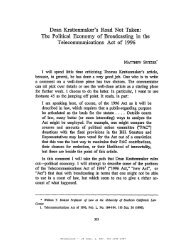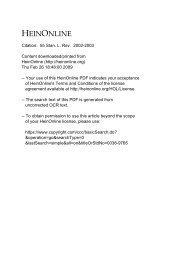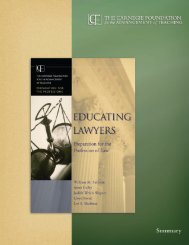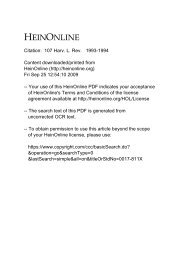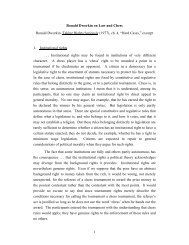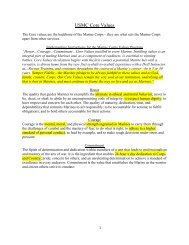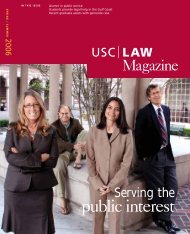“A glance at the <strong>USC</strong> <strong>Law</strong> <strong>School</strong> catalogues before Burby arrived indicates onlyscattered courses utilizing case books. Coinciding with Burby’s 1926 arrival, casematerials became part <strong>of</strong> the way law was taught and learned to the present.““Soon after Bill Burby made the case method the lingua franca <strong>of</strong>the <strong>Law</strong> <strong>School</strong>, John Bradway expanded its vocabulary; Bradwaymoved the teaching <strong>of</strong> law from the case book to the streets.“how. On the first topic, Smith had plenty <strong>of</strong> company;after 1890, growing numbers <strong>of</strong> legal mavens — such asJames Brown <strong>Scott</strong> — argued to make legal educationthe province <strong>of</strong> law schools and universities rather thanthe uncertain ways <strong>of</strong> legal apprenticeship. In 1890there were 60 law schools in America; a decade laterthere were 102; Smith, who learned law in Virginia viathe apprentice system and wrote disparagingly thereafterabout the experience, recognized in this movementand the foundling <strong>USC</strong> <strong>Law</strong> <strong>School</strong> confirmation <strong>of</strong> histhinking.On the second issue, however, Pr<strong>of</strong>essor Smith andhis dean James Brown <strong>Scott</strong>, were formidable opponents.<strong>Scott</strong>, with two degrees from Harvard and a lawdegree from Heidelberg <strong>University</strong>, possessed the mostformally educated legal mind in the city. His years atHarvard persuaded him that the correct way to teachlaw was by the case system. The case method, thereflected teaching style advanced by ChristopherColumbus Langdell, founding dean <strong>of</strong> the Harvard <strong>Law</strong><strong>School</strong> in 1870. In the Los Angeles <strong>Law</strong> <strong>School</strong>’s 1898catalogue, <strong>Scott</strong> advised prospective students that theprevailing form <strong>of</strong> “instruction will be conductedaccording to what is known as the ‘case system.’ ” Tounderscore the message, <strong>Scott</strong> recommended that students“wishing a clear understanding <strong>of</strong> the case system”would be rewarded by reading Harvard law pr<strong>of</strong>essorEugene Wambaugh’s “admirable work,” The Study<strong>of</strong> Cases (1892).An apostle <strong>of</strong> Langdell, <strong>Scott</strong> understood that the casesystem was about both case and system; cases were theprimary material <strong>of</strong> legal study while system suggestedthe method by which cases were to be studied by students;and, through the process <strong>of</strong> eduction – theSocratic method – pr<strong>of</strong>essors would determine what studentswere thinking about a case. For Langdell, writtenappellate cases were the primary source material forlegal study and research; judicial opinions made law.The law library, then, was the laboratory for legal education;the library was to law what the laboratory was tothe study <strong>of</strong> chemistry and physics; in clear language,Langdell asserted the study <strong>of</strong> law through cases was science.To abet this scientific inquiry into law, Langdellpublished the first <strong>of</strong> many casebook collections in1871. Langdell’s years as dean <strong>of</strong> Harvard <strong>Law</strong> <strong>School</strong>reshaped the way Harvard taught law and the Americanlegal academy as well; when Harvard law schoolsneezed, American law schools caught cold.With the verve <strong>of</strong> the Confederate cavalry<strong>of</strong>ficer that he once was, Smith charged intoLangdell’s arguments. His chief salientassaulted the case system on moral grounds but he alsoquestioned the case method in the name <strong>of</strong> pedagogicalefficiency. In the classroom the Socratic method wasslow going; at best, it was suitable for degree-wieldingstudents — Harvard students. When Smith commencedhis teaching life in 1898, the Los Angeles <strong>Law</strong> <strong>School</strong>accepted students who were at least 18 years old andwho could demonstrate that their previous educationprepared them to study law; by comparison, Harvardwas only admitting students with college degrees. Thetypical law student in Smith’s classes had not attendedcollege. So, for practical pedagogical reasons, the casesystem was unsuitable for his students. But in “TheTrue Method <strong>of</strong> Legal Education” (1890), Smith rejectedLangdell’s case system because <strong>of</strong> its pretensions to be ascience. Langdell’s claim for law as science, as the application<strong>of</strong> inductive thought in search <strong>of</strong> general principleswithout regard to moral principles was for Smithuntenable. For Smith, law emanated from fundamentalissues <strong>of</strong> morality and reason, neither <strong>of</strong> which he discernedin the thinking <strong>of</strong> his Harvard-trained contemporaries.For reasons <strong>of</strong> pedagogical efficiency and morality,Smith chose not to teach law at <strong>USC</strong> using the strictassumptions <strong>of</strong> Langdell and his followers. An eclecticapproach using the works <strong>of</strong> legal philosophers, lectures,illustrated with cases from law as well as from literatureand the classics informed Smith’s legal pedagogy;glimpses <strong>of</strong> early <strong>USC</strong> <strong>Law</strong> <strong>School</strong> catalogues suggestthat most <strong>of</strong> his faculty colleagues followed his example.Despite his convictions, intellectual courage, and the6 <strong>USC</strong> LAW • SPRING 2000<strong>USC</strong> LAW • SPRING 20007
“It is noteworthy that the clinic Bradway founded at <strong>USC</strong> in 1928 continuestoday as the Legal Aid Foundation <strong>of</strong> Los Angeles. At <strong>USC</strong>, clinical courses havebeen an integral aspect <strong>of</strong> the law curriculum for 72 years.““<strong>USC</strong> <strong>Law</strong> <strong>School</strong> understands that law is part <strong>of</strong> a comprehensivesocial context, rather than an institution studied distant from personaland broad social influences.“temporary victory at <strong>USC</strong> <strong>of</strong> his teaching philosophy,Smith’s understanding <strong>of</strong> the nature <strong>of</strong> law and legal educationwas overrun by the Langdellite siege on the legalacademy; by 1915, the assaults <strong>of</strong> the Harvard men prevailedon behalf <strong>of</strong> the case method. The same year, Smithdied at his desk in 1915; several local obituaries noted hewas editing another work at the moment <strong>of</strong> death.“Do You Believe in the Case Method?”After meeting with a group <strong>of</strong> faculty in <strong>Dean</strong> OrrinEvans’ <strong>of</strong>fice on the first floor <strong>of</strong> the old law schoolbuilding in 1964, Martin Levine, a freshly minted Yale<strong>Law</strong> <strong>School</strong> graduate, applying for an academic appointment,was approached in the hall by the venerableWilliam Burby. Burby posed one question to Levine:“Do you believe in the case method?” “Yes, I do,”Levine guessed. “Good,” replied Burby, who then leftthe bewildered Levine to wonder how such a clippedexchange about the case method could apparently yieldso much satisfying information. For Burby, who seemedto live in and for the question, it was the only questionthat mattered; he had staked his entire law school career— 56 years in all, 38 <strong>of</strong> them at <strong>USC</strong> <strong>Law</strong> <strong>School</strong> — onteaching via the case method.William E. Burby (1893-1982) did not plant the seed <strong>of</strong>the case method at <strong>USC</strong> but he was connected to <strong>Scott</strong>’smissionary work. Ten years after <strong>Scott</strong> left Los Angeles,he was teaching law in Washington D.C. and serving asthe founding general editor <strong>of</strong> the American CasebookSeries, the teaching tool <strong>of</strong> the Langdellites. An earlyrecruit to <strong>Scott</strong>’s Casebook Series was <strong>University</strong> <strong>of</strong>Michigan law pr<strong>of</strong>essor Ralph W. Aigler, whose two volumework, Titles to Real Property, appeared in 1916 andwent through many editions.One <strong>of</strong> Aigler’s brightest students, William E. Burby,graduated from the Michigan <strong>Law</strong> <strong>School</strong> in 1922. AtMichigan, two features <strong>of</strong> his later life at <strong>USC</strong> were evident:his intelligence — he graduated Order <strong>of</strong> the Coif— and his penchant for bow ties; a graduation pictureshows Burby already in the well dressed mufti that washis emblem at <strong>USC</strong>. After Michigan, Burby taught in thelaw schools <strong>of</strong> Notre Dame from 1922 to 1924, and the<strong>University</strong> <strong>of</strong> North Dakota from 1924 to 1926. In 1926Burby joined the <strong>USC</strong> law faculty as its second full-timefaculty member. With Robert Kingsley, Charles Carpenter,Stanley Howell, and Orville Cockerill, Bill Burbysecured the case method as the prevailing means <strong>of</strong>studying law at <strong>USC</strong>.Aglance at the <strong>USC</strong> law school catalogues beforeBurby arrived indicates only scattered coursesutilizing case books. Coinciding with Burby’s1926 arrival, case materials became part <strong>of</strong> the way lawwas, and is, taught and learned. As if to give a friendlyevaluation <strong>of</strong> his former student’s commitment to thecase method, Pr<strong>of</strong>essor Aigler taught at <strong>USC</strong> <strong>Law</strong> <strong>School</strong>during the summer sessions from 1931 to 1933. Aiglerneedn’t have worried; Burby routinely used his mentor’sproperty case book in his classes. For those studentswho learned law at <strong>USC</strong> during Burby’s tenure, mention<strong>of</strong> his name conjures up recollections <strong>of</strong> the case methodand a demanding Socratic inquiry. Perhaps every lawschool has its version <strong>of</strong> Pr<strong>of</strong>essor Kingsfield, thedemanding, feared yet revered law pr<strong>of</strong>essor in the filmand television series, Paper Chase; in the memories <strong>of</strong>many <strong>USC</strong> law graduates, that man was William Burby.Within five years <strong>of</strong> his arrival at <strong>USC</strong>, Burby wasalso a contributor to the American Casebook Series.Evidence <strong>of</strong> his teaching methods exists as early as 1931with his syllabus <strong>of</strong> cases on community property; twoyears latter, Burby’s Cases on Community Propertyjoined the list <strong>of</strong> his Michigan law school mentors; aforth edition appeared in 1955. By 1943, Burby publishedhis first Hornbook on Property <strong>Law</strong>; and, in 1946,he found a publishing niche for his famous bar reviewcourse. Subjects in this series included criminal law,property, evidence, business law and a general refreshertext for students preparing to take the bar examinationWhile Burby made his pr<strong>of</strong>essional mark chiefly as apr<strong>of</strong>essor <strong>of</strong> property and community property, over thecourse <strong>of</strong> nearly four decades he also taught trusts, billsand notes, torts, and common law pleading. Two <strong>of</strong> hisprotégés — Shelden Elliott LLB ‘31, LLM ‘32, and HenrySpringmeyer JD ‘30 — succeeded so well with Burby andhis colleagues that they returned to the faculty by themid-1930’s; Elliott emulated his mentor in his teachingmethod and as active author <strong>of</strong> monographs on theadministration <strong>of</strong> justice, legal education, and legislationin addition to case books.The Most Notable ExperimentSoon after Bill Burby made the case method the linguafranca <strong>of</strong> the <strong>Law</strong> <strong>School</strong>, John Bradway expanded itsvocabulary; Bradway moved the teaching <strong>of</strong> law fromthe case book to the streets. John Saeger Bradway (1890-1985) joined the faculty in the summer <strong>of</strong> 1928 to establisha legal clinic at the law school. In Bradway, then<strong>Dean</strong> Justin Miller found the nation’s foremost proponent<strong>of</strong> integrating a practicum into the American lawschool curriculum. Bradway’s notion that a legal clinicwas both an exercise in altruism, as well an importantmeans <strong>of</strong> learning, won the attention <strong>of</strong> a contemporaryABA report. It declared Bradway’s work as the “. . . mostnotable experiment [in legal education] is the legal aidclinic <strong>of</strong> the <strong>University</strong> <strong>of</strong> Southern California <strong>Law</strong><strong>School</strong>.”The notion <strong>of</strong> a legal clinic derived from late-nineteenthcentury developments in medical education,which invented medical clinics as a means <strong>of</strong> injectingpractical experience into classroom instruction. Medicalstudents, working under the supervision <strong>of</strong> practicingphysicians, attended to poor patients in local clinicsand hospitals. By 1910, several law schools includingHarvard, the <strong>University</strong> <strong>of</strong> Minnesota, the <strong>University</strong> <strong>of</strong>Denver, and particularly Northwestern were experimentingwith the medical school model, establishinglegal clinics for the poor managed by practicing attorneyswho supervised law students.John Bradway, a 1914 graduate <strong>of</strong> the <strong>University</strong> <strong>of</strong>Pennsylvania <strong>Law</strong> <strong>School</strong>, found his life’s work in thelegal clinic model. Inspired by his deep Quaker socialconscience, Bradway’s legal training launched him into anational role as chief spokesperson for the national legalaid movement. Secretary to the National Association <strong>of</strong>Legal Aid Organizations, he directed the PhiladelphiaLegal Aid Society from 1914 to 1920 while teaching atthe Pennsylvania <strong>Law</strong> <strong>School</strong> and <strong>School</strong> <strong>of</strong> Social Work.Bradway spent just three years at <strong>USC</strong> but hiswork has endured for more than seven decades;a prolific writer, he authored scores <strong>of</strong> books andarticles on law and social work, the bar and public relations,and legal clinics. At the center <strong>of</strong> his oeuvre arefive essays published in the Southern California <strong>Law</strong>Review between 1928 and 1931 on the nature, organization,administration, and educational value <strong>of</strong> a clinicallaw school course. Collectively, they became the handbookfor law school legal aid clinic programs throughoutthe country. While Bradway’s keen social agenda imaginedthat the <strong>USC</strong> legal clinic might stimulate a student’ssocial conscience, he fully understood that such aclinic needed to find justification as part <strong>of</strong> a law schoolcurriculum. For Bradway, the course — open to thirdyear students — was a means <strong>of</strong> demonstrating the interconnectedness<strong>of</strong> legal theory and practice which were“not and ought not to be considered separate things.”Evidence <strong>of</strong> the union <strong>of</strong> theory and practice occurredevery weekday afternoon and on Saturdays at the northeastentrance <strong>of</strong> the <strong>Law</strong> <strong>School</strong> building; here clientsseeking counsel entered the law school, climbing thestairs to the second floor where they met with two thirdyearlaw students; this simple inclusionary gesture distinguished<strong>USC</strong>’s legal aid clinic from others. At the<strong>University</strong> <strong>of</strong> Minnesota clinic, for example, studentswent into the city to meet clients. Solomon Rosenbaum‘30, describing himself as a callow third-year, recalls theexperiences gained with live clients as among the mostvaluable in his life as a law student. The legal cliniccourse provided students with the opportunity to synthesizepractice and theory.8<strong>USC</strong> LAW • SPRING 2000<strong>USC</strong> LAW • SPRING 20009


